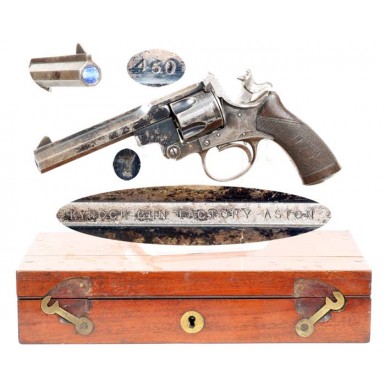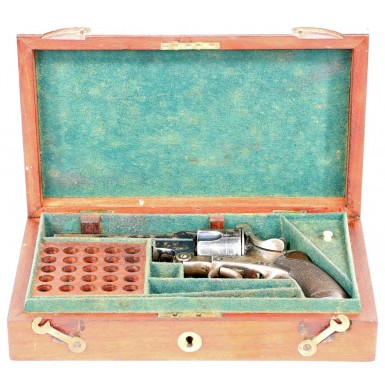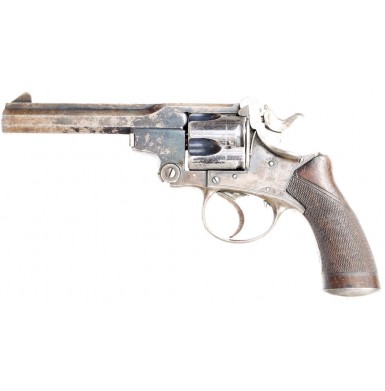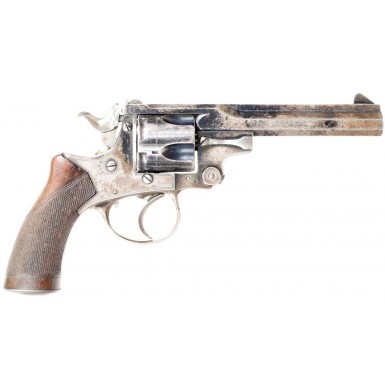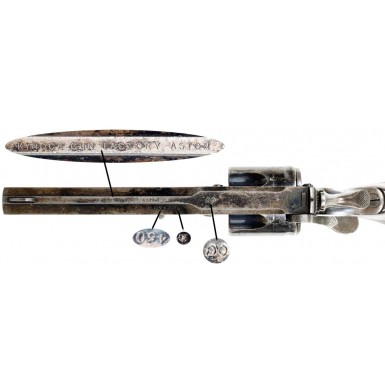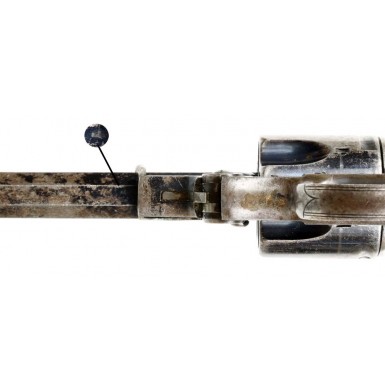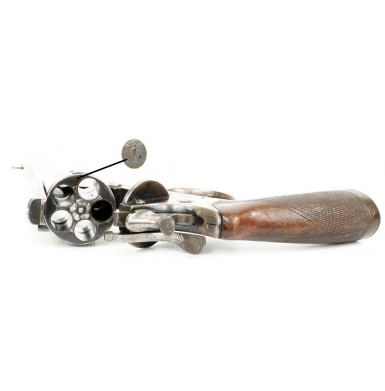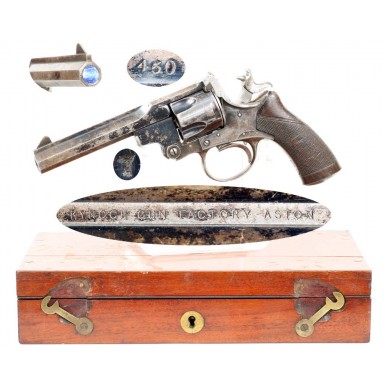William Tranter was one of the most prominent Gun, Rifle & Pistol Makers in the Birmingham trade during the mid-19th century. Tranter was born in 1816 and died in 1890. During his working life, his name became synonymous with quality handgun design and manufacture, although he produced small arms of all types and held patents related to all types of firearm actions. He went into business for himself circa 1840, after completing his apprenticeship with Hollis Brothers & Co, which he had begun in 1830. Tranter continued working actively in the gun trade until 1885, just five years before his death. After his decade of work learning the gun trade at Hollis Bros & Co (later Hollis & Sheath), in 1840 Tranter bought the established gun making business of Robert Dugard at 29 “ Whitehall Street. Over the next decade, he worked for himself and in joint ventures with his old employers John & Isaac Hollis as well as with Isaac Sheath. By 1850 he had located his primary business at 50 Loveday Street, where he was listed as having “shops, sheds, steam machinery, yard & premises” and became one of the first of the Birmingham gunmakers to utilize steam powered machinery. Tranter secured his first British patent related to firearms in October of 1849 when he registered a “pepperbox mechanism and lever catch for pistol locks”. In January 1853, he registered British Patent Number 212 (1853) for a pair of “self-cocking” pistol mechanisms and a safety mechanism. In December of the same year he registered designs for a double-action revolver mechanism, lubricated bullets and wadding, and a breech loading mechanism, all of which were covered by Patent Number 2921 (1853). In August of 1856 he registered the designs for a “double trigger revolver mechanism”, along with several other designs, all of which were covered by British Patent Number 1913 (1856). Tranter continued patenting firearm designs as late as 1887, after he had left active participation in the gun trade. One of Tranter’s most successful series of arms were his “self-cocking” percussion revolvers, which were initially introduced in 1853. The earliest revolvers utilized Robert Adams patent for a solid, one-piece frame and barrel that were machined from a single forging. Tranter’s initial production run of revolvers included both M-1851 Patent Adams style lock works, and Tranter's own patented lock works. The original “Tranter” type revolvers, known to collectors as 1st Model Tranters had no provision for an attached loading lever. Later production 2nd and 3rd Model guns offered improvements to the loading system with attached levers. All of these first three models were based on his “double-trigger” system (initially referred to as his “hesitating mechanism” on the early production guns), which utilized a second “trigger” under the trigger guard to rotate the cylinder and cock the hammer. The trigger inside the triggerguard was used to trip the sear and release the hammer. Tranter then introduced his 4th Model Tranter revolvers (circa 1856), which used a single trigger, and had what would today be called a conventional “double action” lock work. The Tranter patent revolver was the primary competitor with the Adams and Adams-Beaumont patent revolvers in England, and was also exported widely. Pre-Civil War Tranter revolvers are known with US retailer marks, indicating that his designs were at least somewhat successful in the United States. The majority of the retailer marked guns are from the south, with the largest majority of them being marked by New Orleans retailers. Based upon extant examples, the firm of Hyde & Goodrich (later Thomas, Griswold & Co) appears to have been the primary importer of Tranter Patent revolvers into the southern United States. Most of these retailer marked guns were sold cased with accessories, although some guns were certainly sold without the expensive casings and accouterments. During the course of the Civil War, it appears that the importation of Tranter revolvers was somewhat limited, at least in terms of Confederate central government purchases. However, period advertisements in the south and extant examples with southern provenance make it clear that the guns were imported by blockade-runners as speculative items for sale in the south. Despite his success both in England and abroad, William Tranter kept looking forward to new markets and designs. It was clear to him that the self-contained metallic cartridge was the wave of the future and he put significant efforts in design in that direction. His first cartridge offerings, as the height of the American Civil War period. He received English Patent #2067 (1862) for a variety of revolver improvements that he would subsequently include in his new line of cartridge revolvers, and the following year received English Patent #1862 (1863) for more improvements to cartridge revolvers. The first cartridge handguns to be introduced by Tranter were spur trigger, small caliber rimfire pistols in .230 and .320 calibers. The guns had solid frames, and were direct competitors to the hinged frame #1 and #2 revolvers from Smith & Wesson. However, Tranter knew that pocket sized spur trigger revolvers with low power cartridges were not going to win military contracts and he went to work on creating a larger, more powerful revolver. His offering was based upon his large frame 4th Model percussion revolver, and was initially manufactured in .442RF, although a .450 centerfire variant was offered fairly soon after the initial introduction. The most identifiable feature of the Model 1863 “Army” revolver was the side mounted, compound ejector mechanism that resembled a percussion revolver’s ramrod much more than an ejection system. The system was mounted on the right side of the barrel and frame and by lowering the lever, a plunger was pushed into the chamber push out the spent cartridge. The plunger was roughly the internal diameter of the casing, as Tranter had discovered that a simple ejector rod could actually punch through the bottom of a soft copper rimfire case, leaving the case hopelessly stuck in the cylinder chamber. A conventional loading gate at the rear of the recoil shield allowed the loading and unloading of the cartridges. A smaller framed variant of his Model 1863 was also introduced as the “House Defence” Revolver, in small calibers like .230, .297, .320 and .380. In typical Tranter style, the revolvers rarely bore his mark beyond a “Tranter’s Patent” mark on the frame and ejector system, and usually were left otherwise blank for retailer to apply his mark on the topstrap. A serial number and sometimes assembly numbers were usually the only other markings. With the introduction of the .450 CF version of the revolver, Tranter also introduced a floating firing pin in the frame of the gun, which was struck by the blunt nose of the hammer when the trigger was pulled. By 1868 Tranter had received a new patent for a series of improvements to the cartridge revolver (English Patent #282 of 1868) and his Model 1868 revolver quickly superseded the Model 1863. The new Model 1868 was also a solid frame, gate loading revolver based upon Tranter’s 4th Model double-action lockwork. The revolver had a somewhat fragile looking ejector rod mounted on a pivot under the barrel. To use the rod, the revolver was placed on half-cock the loading gate opened, and the rod swivels to the right, allowing it to be used to push empty cartridges out of the chambers. Unlike the ejector on the M-1863, the new rod did not have a large head, but was a more traditional thin rod ejector. The M-1868 was offered in compact, 5-shot pocket sizes, chambered for the .320RF and .380 CF and RF cartridges, and in a larger frame, 6-shot variant, chambered in .442RF, .450CF and .500CF. These revolvers remained in fairly constant production through the late 1870s, when the new Model 1878 and Model 1879 revolvers superseded them. The Model 1879, covered by British Patent #2855/1897 was Tranter’s somewhat belated attempt to capture the portion of the revolver market that was being dominated by various top-break designs that allowed for simultaneous extraction. The British government was on the verge of adopting the Enfield Mk1 revolver, a hinged frame design in .476 and Tranter must have had hopes of providing a superior alternative. The Model 1879 was a hinged frame revolver with a tip down barrel, a five or six shot cylinder and a star extractor system that was actuated by barrel motion. A single, large thumb latch on the left side of the frame allowed the pistol to be opened and locked it closed. The revolver was manufactured in .380 CF with a six-shot cylinder and a 4” barrel as standard, or .450 CF with a five or six shot cylinder and 4” and 6” barrels standard. Blued finishes and walnut grips appear to have predominated, with some nickel guns produced as well. What Tranter did not know was that at that time, there was no possibility of a private company competing with a War Department design that was being produced at the Royal Small Arms Factory at Enfield Lock. It would take nearly a decade for the War Department to realize that the private sector was better equipped to design and produce a suitable service revolver. During that time period, however, William Tranter retired in 1885 and he leased his Aston gun factory to George Kynoch. Kynoch would continue to produce some later pattern Tranter revolvers from parts on hand, but they would be labeled as the work of the Kynoch Gun Factory, Aston, and most would not bear Tranter marks of any kind.
Offered here is a FINE condition example of what collectors refer to as a Tranter-Kynoch revolver, which is in reality a Tranter M-1879 Revolver produced by the Kynoch Gun Factory sometime around 1885 (or slightly after), when they took over the Tranter facility as well as his remaining parts on hand. The gun bears no Tranter markings, and the top rib of the 4 15/16” long octagonal barrel is simply marked: KYNOCH GUN FACTORY. The other markings on the gun are the caliber mark .450 on the barrel, assembly (or serial) number 7, the usual Birmingham commercial proof marks and two different sets of small letter markings. The serial number is found on the bottom of the barrel and on the rear face of the cylinder. It is likely on some internal components as well. The proofs are found on the right side of the frame below the hinge, on the left angled flat of the barrel between the top strap and the caliber mark, and at the rear of the cylinder flutes. The letters O.C are stamped on the top strap and two letters are stamped on the lower left side of the frame near the grip junction. These letters are double-stamped or over-stamped and I can’t quite decipher them. The revolver has some simple engraved enhancements, including a flower motif around the hammer screw on both sides of the frame, a similar (but simpler) motif on the release latch and the grip screw heads. Simple boarder line engraving is found around the edges of the frame below and behind the cylinder, as well as on the trigger guard bow, with slightly more complex border engraving around the muzzle. The revolver is blued with the hammer and frame release left in the white and checkered one piece walnut grips. The double action trigger mechanism has the exposed sear release at the rear of the triggerguard found on 4th Model Tranter revolvers, and is likely the same basic double action mechanism used by Tranter from the early 1860s. One of the features Tranter incorporated into the Model 1879 was a rebounding hammer, and this revolver retains that feature even though it is made by Kynoch. The revolver retains about 25%+ of the original blued finish, which is most evident on the left side of the frame, forward of the cylinder, on the rear portion of the barrel and in the cylinder flutes. The finish appears to have primarily flaked away. The balance of the revolver has a mostly smooth, mottled brownish-gray patina with traces of plum. The metal shows no real pitting, but there is some very lightly scattered pinpricking and some minor surface oxidation present. The revolver is mechanically functional and times, indexes and locks up as it should. The latch system remains tight and secure with only the usual minor end shake typical of hinged frame designs. The extractor star functions smoothly, but does not “snap” down at the end of the barrel travel like Smith & Wesson style designs and my research could not conclude if it is supposed to. It appears that like some English simultaneous extraction systems, it was only designed to lift the cartridges from the chambers, with the loaded rounds being long enough to still be partially in the chamber and only the fired ones being short enough to be completely extracted. The lever on the front of the frame allows the extraction system to be defeated and the cylinder to be removed from the revolver. The bore of the revolver is in about FINE condition as well. It is mostly bright with crisp nine-groove rifling. There is some minor oxidation and fine pitting present in the grooves. The one-piece wood grip remains in about very good condition. It is solid and complete and free of any breaks, cracks or repairs. The grip shows the usual bumps and dings from handling and use and checkering shows light to moderate wear. The revolver is contained in its original Tranter style mahogany casing with its original green baize lining, which remains in FINE condition. The casing has a section with 25 holes for the storage of 25 .450 cartridges, as well as a triangular lidded compartment and several compartments for the storage of various accessories, all of which are empty. The case retains its two original brass locking hasps, both original brass “bible” hinges, an unmarked round brass escutcheon on the lid and a brass lock plate. There is no key. The case is in about VERY GOOD+ to NEAR FINE condition, and retains much of its original finish with the usual minor bumps and dings from handling and use. The only condition issue worth mentioning is the grain crack that runs the width of the lid. This is solid and stable, but does not materially detract from the display of the revolver and casing. No retailer label is present in the case, and it does not appear that there every was one.
Overall this is a very nice example of a scare, late Tranter cartridge revolver produced by the famous Kynoch Gun Company, a short-time subsidiary of the even more famous Kynoch ammunition company. The Kynoch Gun Company was only in business from 1885 to 1888, when George Kynoch retired and the company became the Aston Arms Factory, under the direction of Kynoch’s former superintendent Henry Schuland. This business was short lived as well, closing in 1891. As these revolvers were produced for such a short period of time in rather small numbers they are difficult to find on the collector’s market today. This would be a wonderful addition to any advanced collection of early British cartridge revolvers, and particularly a collection of Tranter revolvers, as it represents the last of the Tranter designs to be produced.
SOLD
